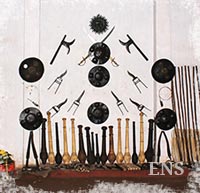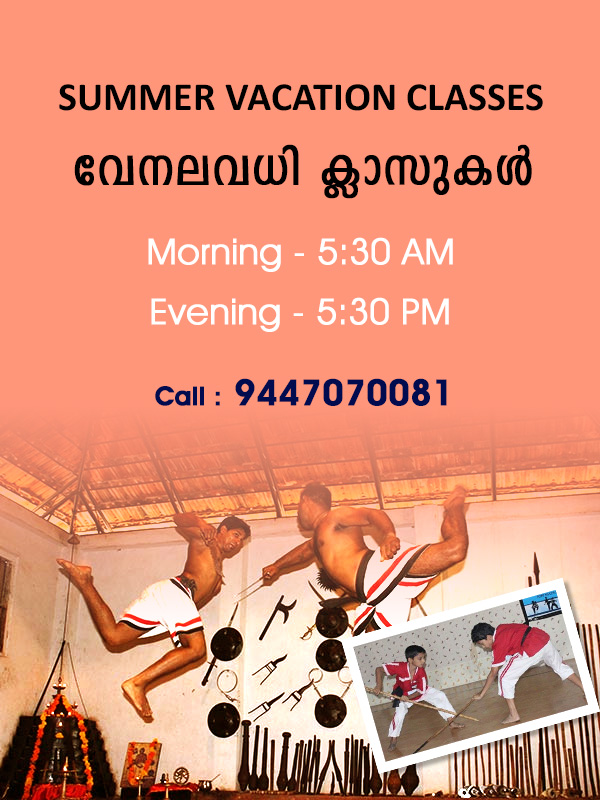The Systems

The Kalari training is based on an elaborate system of physical exercises. The practical experience of the body movements strengthens the knowledge of the discipline. The constant practice makes the body ‘an eye’ and adds to agility and strength. At age seven, the student is recruited for his training under a GURUKKAL. Oil massage or Uzhichil is an essential part of training. The verbal commands of the Gurukkal known as VAYTTHARI are obeyed and repeated to grasp the body movement. Each of them helps to recollect memory and leads to correct movements. Before practice, the student covers their bodies with oil prepared by the Gurukkal. This specially prepared oil gives strength and flexibility, warms up the muscles and prevents muscle strain.
Kalarippayatt comprises two major styles which being divided geographically, are consequently known as the NORTHERN STYLE and SOUTHERN STYLE. The Northern Style is practiced mainly by the NAYARS, a Malayalam–speaking people who are part of the ARYAN CULTURAL tradition of North INDIA. Tamil–speaking people who are a part of DRAVIDIAN CULTURAL and descendents of the area’s ancient inhabitants, who practice the Southern style, occupy the Southern most part of India. A few Malayalam speakers also practice the Southern style in their area.
Although the Northern and Southern style are obviously closely related, and Kalarippayatt generally is quite different from the other Martial Arts, significant distinctions can be made between the two styles. At the geographical boundary between the two cultural groups and fighting styles, there is some overlap.
NORTHERN STYLE
Sage Parasurama was the Master of Northern style Kalarippayat. The Northern style Kalarippayat is divided into four part of training. They are: Maithari, Kolthari, Ankkathari, and Verum kaithary.
MAITHARI [Body control Training]
This involves 12 graded body exercise sequence, which include: twists and turns of the body, leaps and poses. A single sequence constitutes a Payatt. In advance stages, one attains various ‘SIDHIS’ [Skills], viz. speed, accuracy, force, stamina, co-ordination, mastering balance, flexibility and principles of movement in space as well as understanding the continuous flow of energy in the body.
KOL- THARI [Kol – means stick]
This is the second stage of Kalarippayatt. It involves training in wooden weapons like ‘KETTUKARI’ [12 span staff], ‘MUCHAN’ [ 3span stick], and ‘OTTAKOL’ [‘S’ curved stick]. Training in Ottakol is a stepping-stone towards to proper execution of advanced Kalarippayatt. Long practice of this stage enables a student to gain control over the weapon. Even a small wooden staff can become a weapon in the hands of a practitioner with dazzling power (even against a heavily armed adversary).
ANKATHARI [Metallic weapon fights]
Ankathari involves combat training with weapons like the DAGGER [kadaras], the SWORD&SHIELD [udaval & paricha], the SPEAR [kuntham], the MACE [gatha], the AXE [mazhu], the KNIFE [kathi] and the LONG FLEXIBLE SWORD [urummi].
VERUM KAITHARI [bare and fights]
Bare hand fights are a post-graduate course in Kalaripayat. Here an unarmed combatant fights with an armed enemy and puts him down. Various activities like OZHIVUKAL [skipping], IRRAKKAM [stepping back], KAYATTAM [stepping forward], THADA [blocking], PIDUTHAM [catching] as well as blows and hits at the VITAL POINTS (or Marmmam) of the body, are the main features to this practice.
THE SOUTHERN STYLE
This system gives more importance to footwork [Chuvadukal] and attacks with hands. The special feature of the southern system is ADIMURA – 64 [64 types of attacking blows & locks]. The bare hand has more importance in Adimura, Thattumura, Pidimura, Marmmamura, and Marmma Adi. Locks and release of locks are also important. In the foot work systems there are 84 types of movements. They are ANKACHERY CHUVAD [basic footwork], BALIVAZHI [monkey type footwork], ANNKAM VETT CHUVAD [bare handfootwork], NAALANNI CHUVAD[heavy-footwork], KARINADA CHUVAD [elephant footwork], CHEENA YADI CHUVAD [drunken monkey footwork], and THATTUMARMA CHUVAD [strikes to the vital points]. Ner-Chuvad, Privu-Chuvad, Vatta-Chuvad, Chariv- Chuvad, Otta-Chuvad, and Panchavarna –Chuvad are also included in the 84types of movements.

 Online Class
Online Class